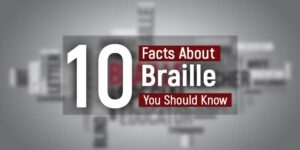In today’s interconnected world, social media plays an important role in connecting with people, sharing their thoughts, and fostering communities.
Everybody is on social media, but there is still a large part of the audience that does not get to experience the digital realm the same way.
For visually impaired individuals it’s difficult to navigate social media platforms. A question may arise, how do blind people use social media?
Customers expect to engage with brands on social for customer services.
Social media is filled with videos, GIFs, images or emojis, so accessing those becomes a challenge for visually impaired users.
Inaccessibility creates a barrier to equal access to communication with customers with visual impairment.
In this blog, you’ll learn tips on how braille transcription you can make social media accessible to the visually impaired.
Why Accessibility Matters?
Before diving into what are the tips you should consider making your social media accessible.
You want to participate in a conversation or access information, stay updated, or just engage with your friends and family, but can’t. Imagine how can the visually impaired feel excluded, as these prevent you from fully experiencing the digital world.
This is the reality for millions of visually impaired individuals. Ensuring social media accessibility is not just a matter of convenience; it’s a matter of basic human rights and inclusivity.
Practical Tips for Social Media Accessibility
1. Alt Text for Images
Adding Alt text when posting images is an easy way to give your audience who are visually impaired a description or explanation for the video or the content.
Twitter, Instagram, Facebook and Linkedin all have the option of adding alternative texts to that post.
This allows screen reader software to convey the meaning of the image to the user. For instance, instead of just “Beautiful sunset”, use “A vibrant orange and pink sunset over a calm ocean.
Also, avoid adding text to videos or images, as screen readers will be able to understand.
2. Considerate Use of Emojis
Emojis are a fun way to add expression to your posts. However, for visually impaired users, they can be confusing.
Always provide a brief description of the emoji’s meaning in your text.
3. Clear and Concise Language
Avoid jargon or overly complex language. Clear, straightforward communication benefits everyone, including those using screen readers.
4. Descriptive Hashtags
When using hashtags, make sure they are descriptive and easy to understand. Capitalizing each word can make them more accessible for screen readers.
5. Video Accessibility
For videos, provide accurate captions or transcripts. This allows visually impaired users to engage with your content on an equal footing with others.
6. Readable Fonts and Color Contrast
Ensure that the text on your posts has high contrast with the background. This makes it easier to read for those with low vision.
The Impact of Inclusive Design
By implementing these simple yet powerful strategies, we can create a more inclusive social media environment.
This not only benefits visually impaired individuals but enriches the experience for all users. Inclusivity in design is not about creating separate experiences; it’s about creating a digital world where everyone can participate, contribute, and connect.
Social Media Platforms and Accessibility
Facebook has taken significant steps towards accessibility. They’ve released AI-powered automatic alt text for screen readers. Their accessibility statement covers keyboard shortcuts, closed captions, and assistive technology questions.
They also provide tips for using both the feed and messaging. Additionally, there’s a Meta Accessibility page to stay updated on accessibility developments.
Instagram’s accessibility features include automatic alt text, which can be edited before posting. Given its focus on visuals, compatibility with screen readers is crucial. Notable figures with visual impairments, like Paralympian Anthony Ferraro and content creator Lucy Edwards, actively engage on the platform.
- Snapchat
Unfortunately, Snapchat lags behind in terms of accessibility support. Their support page doesn’t address accessibility with screen readers or assistive technology, despite its popularity among Millennials and Gen Z.
- TikTok
TikTok has made strides in accessibility since 2020, offering auto captions and other features like text-to-speech, animated thumbnails, and photosensitivity toggles. These enhancements cater to a diverse audience, including those with varying abilities.
- Tumblr
Tumblr employs hashtags to assist users with visual disabilities. By using tags like #captioned or #uncaptioned, individuals with visual impairments can easily access captioned content or filter out uncaptioned posts.
Twitter incorporates AI-captioning for images, although users need to enable this setting. Their accessibility features page outlines support for individuals with visual, auditory, mobility, and cognitive disabilities. Additionally, the Twitter Accessibility profile, @TwitterA11y, shares updates on accessibility in the industry.
- YouTube
YouTube, owned by Google, is compatible with screen readers. They offer detailed accessibility instructions for using the platform with a screen reader on various devices. This allows creators of all abilities to thrive on the platform. Influencers like Molly Burke and content creator Tommy Edison, both with visual impairments, have substantial followings.
Conclusion
In a world that is becoming increasingly digital, ensuring that social media is accessible for everyone is a responsibility we all share. By adopting inclusive design practices, we can bridge the digital divide and create a more connected and empathetic online community.
Together, let’s make social media a space where every voice is heard and every person, regardless of their abilities, feels valued and included. Explore our website and connect with our expert Braille transcription services. Experience the joy of reading in Braille today!







